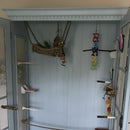Introduction: Bent Wood Homopolar Motor
This is for the Kinetic Sculpture contest.
I have always loved magnets. Specially rare earth magnets. I experimented with the simplest motor possible, the homopolar motor, using the neodymium magnets i have. My arm got tire of holding the battery up though. So I decided to build a wooden battery holder out of strips of balsa bent into an arc.
Please see video below.
Step 1: Materials
Materials:
Neodymium magnet 1/4 x 1/4 inch square or cylindrical
1 sheet 3/16th inch balsa or thinner (actually any thin sheet of wood will work)
Wooden base around 3 x 6 inches
Wood glue
Water
Copper wire
1small screw
1 (or 2) AA battery - rechargeable ones if you want to be responsible.
bit of plastic or small piece of hardwood
Wood stain
1 nail
Tools:
Several vises
some clamps
sandpaper
drill and drill bits
file
paintbrush
Rope
Step 2: Cut Balsa and Soak
Cut the balsa to 10 inches by 1 inch. We need four (4) strips.
Soak in water overnight.
Step 3: Prepare Base
About 1.5 inches from one edge and centered, make a rentangular hole slightly bigger than 1/5 x 1 inch. The armature will be glued into this hole. Use a file to square the hole.
Step 4: Glue Balsa Strips Together and Bend
After a good soaking overnight take the balsa out of the water.
Apply wood glue on each strip and stack the strips together.
Using some scrap pieces of wood to protect the strips from the vise jaws, clamp one end of the strips.
At a mid-point add another clamp or vise.
Slowly and careully bend the balsa.
Clamp the end and use rope or strap or tie-down to keep the wood bent.
Let wood dry completely - about 2 days.
Step 5: Attach the Armature to the Base
Push the straight part of the strips of bent balsa into the base.
Glue it down. Let the glue dry.
Step 6: Make a Hole for the Battery
Drill a hole on the other end of the armature that is a close fit for a AA battery.
Get a strip of plastic and bend it so that one end of battery is supported. Any rigid piece of plastic will do. I cut a piece of plastic from a toy packaging i found in the trash.
Use a small wood screw to secure the plastic to the armature.
Step 7: Add Wire
Get your piece of copper wire. Wrap the wire around the screw holding the plastic in place.
bend one end of the wire so it will touch the top of the battery. bend the other end of the wire so that it will end 1.5 to 2 inches below the bottom of the batter. make a half inch of the wire below the battery parallel to the base..
Step 8: Stain the Wood (optional)
Sand everything down so there are no splinters and everything looks smooth.
Get your wood stain and stain your work.
Step 9: Add Battery, Nail and Magnet
Put the battery in the hole positive (+) side down.
Attach the magnet to the head of the nail.
Attach the point of the nail to the positive (+) end of the battery. the magnet will hold it in place.
Adjust the wire so one end is touching the negative (-) end of the battery.
Adjust the other end of the wire so it is barely touching the magnet.
watch it spin. try adding a second AA battery. Consider using rechargeable batteries.
Another video, this one with my extra messy desk at work.
A note about Round magnets versus Square magnets. Both shapes work, but the square magnet is easier to see the spin and makes a clicking noise. The round magnet is quiter and runs smoother. Becuase the round magnet can be in constant contact with the wire, it spins up much, much faster. The square, because of its corners bounce off the wire and is limited in speed but is more lively.
Another video:
Finalist in the
Kinetic Sculpture Design Contest













